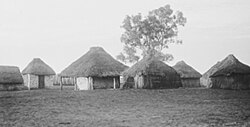IND/Segregation, Protection, Assimilation: Overlapping Themes
It can be difficult to make clear distinctions between these laws, policies and practices because they operated at different times in the different Australian colonies and States. We will concentrate mostly on New South Wales in this module, but it is important to remember that other Australian States had somewhat different histories.
It can also be hard to make clear distinctions between the three approaches because protection, segregation and assimilation tended to overlap and run into each other. Segregating Indigenous people away from non-Indigenous populations had been practiced, for example, since the very early days of colonisation, as non-Indigenous authorities tried to keep Aboriginal people out of developing towns and make them become “settled agricultural workers” (Haebich, 2000, p. 143). But segregation also refers to the twentieth century system of removing Indigenous people onto reserves and missions, often in the guise of ‘protecting’ Indigenous people.
Anna Haebich (2000) describes how segregation, protection, and assimilation were connected:
| “ | From the turn of the century governments around Australia adopted the policy of protection which enshrined contradictory but intersecting sets of philanthropic, ameliorative, punitive and even genocidal rationales, and which resulted in a convenient 'double speak' of stated humanitarian concern and agendas of segregation, assimilation, genocide and profound neglect. This mix seemed to enable everyone, from city humanitarian to brutal frontiersman, to feel comfortable with their stance and convinced that right was being done (p. 143). | ” |
Later assimilation policies have been described as retaining “many of the most destructive ‘Protection’ legislation features over Aboriginal families” with a new focus on surveillance of Indigenous family life (McGrath, 1995, p. 60 & p. 89).
All of these themes, however, involved a high degree of interference by government and other non-Indigenous authorities into Indigenous lives.
